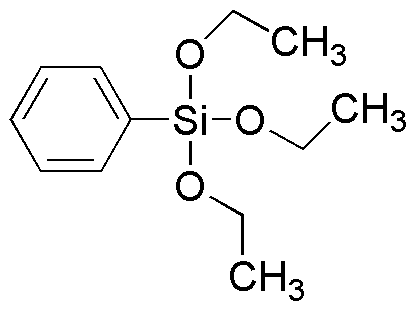Triethoxyphenylsilane is widely utilized in research focused on:
- Adhesives and Sealants: This compound enhances the adhesion properties of various materials, making it ideal for use in construction and automotive industries where strong bonds are essential.
- Surface Modification: It is employed to modify surfaces of glass and metals, improving hydrophobicity and corrosion resistance, which is crucial in electronics and packaging sectors.
- Composite Materials: In the production of composite materials, it serves as a coupling agent, promoting better interaction between organic and inorganic components, thereby enhancing mechanical properties.
- Coatings: Used in the formulation of protective coatings, it provides durability and resistance to environmental factors, making it valuable in marine and industrial applications.
- Silane Coupling Agents: As a silane coupling agent, it improves the compatibility of fillers in polymers, which is beneficial in the plastics industry for producing high-performance materials.
General Information
Properties
Safety and Regulations
Applications
Triethoxyphenylsilane is widely utilized in research focused on:
- Adhesives and Sealants: This compound enhances the adhesion properties of various materials, making it ideal for use in construction and automotive industries where strong bonds are essential.
- Surface Modification: It is employed to modify surfaces of glass and metals, improving hydrophobicity and corrosion resistance, which is crucial in electronics and packaging sectors.
- Composite Materials: In the production of composite materials, it serves as a coupling agent, promoting better interaction between organic and inorganic components, thereby enhancing mechanical properties.
- Coatings: Used in the formulation of protective coatings, it provides durability and resistance to environmental factors, making it valuable in marine and industrial applications.
- Silane Coupling Agents: As a silane coupling agent, it improves the compatibility of fillers in polymers, which is beneficial in the plastics industry for producing high-performance materials.
Documents
Safety Data Sheets (SDS)
The SDS provides comprehensive safety information on handling, storage, and disposal of the product.
Product Specification (PS)
The PS provides a comprehensive breakdown of the product’s properties, including chemical composition, physical state, purity, and storage requirements. It also details acceptable quality ranges and the product's intended applications.
Certificates of Analysis (COA)
Search for Certificates of Analysis (COA) by entering the products Lot Number. Lot and Batch Numbers can be found on a product’s label following the words ‘Lot’ or ‘Batch’.
Número de catálogo
Número de lote/lote
Certificates Of Origin (COO)
This COO confirms the country where the product was manufactured, and also details the materials and components used in it and whether it is derived from natural, synthetic, or other specific sources. This certificate may be required for customs, trade, and regulatory compliance.
Número de catálogo
Número de lote/lote
Safety Data Sheets (SDS)
The SDS provides comprehensive safety information on handling, storage, and disposal of the product.
DownloadProduct Specification (PS)
The PS provides a comprehensive breakdown of the product’s properties, including chemical composition, physical state, purity, and storage requirements. It also details acceptable quality ranges and the product's intended applications.
DownloadCertificates of Analysis (COA)
Search for Certificates of Analysis (COA) by entering the products Lot Number. Lot and Batch Numbers can be found on a product’s label following the words ‘Lot’ or ‘Batch’.
Número de catálogo
Número de lote/lote
Certificates Of Origin (COO)
This COO confirms the country where the product was manufactured, and also details the materials and components used in it and whether it is derived from natural, synthetic, or other specific sources. This certificate may be required for customs, trade, and regulatory compliance.


